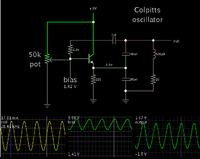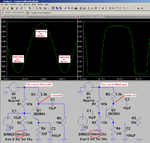Neyolight
Full Member level 5
Hi all
I am building a colpitts oscillator which seems to work just fine. The problem is its "vout" ( shown in the image) is a 100 mV sine wave with a frequency of about 60Khz. I need to square up this sine wave and using another transistor to do so.
At the moment , the second transistor is not turning on as the vout ( that is being fed to its base) is too low at 100mV. Could someone tell me a way to increase the amplitude of the Vout.
Thanks !
Neyo
I am building a colpitts oscillator which seems to work just fine. The problem is its "vout" ( shown in the image) is a 100 mV sine wave with a frequency of about 60Khz. I need to square up this sine wave and using another transistor to do so.
At the moment , the second transistor is not turning on as the vout ( that is being fed to its base) is too low at 100mV. Could someone tell me a way to increase the amplitude of the Vout.
Thanks !
Neyo



